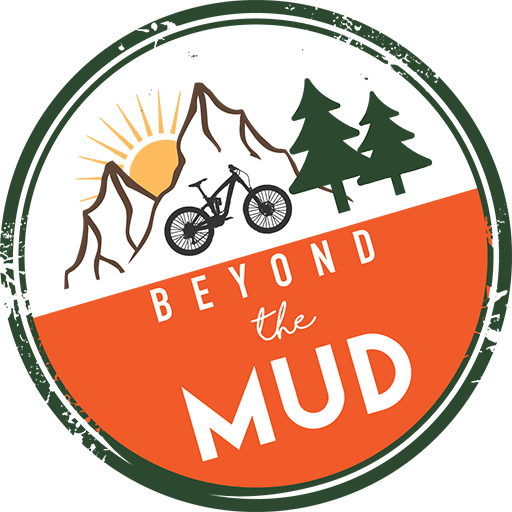
by hattenburrow | Aug 31, 2017 | Coaching, Training
Hi guys and girls this week I thought I’d share with you my Monday training session plan maybe have a go at it yourself.
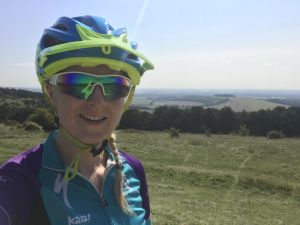
You will need:
- A bike
- not to have eaten for an hour or two previously
- a bottle of water and a snack for when you finish (banana or dates would be my choice)
Find a flattish road where there are no parked cars, tight bends or traffic lights to deal with you need to be able to give it your all safely.
Start by warming up for a good 20 minutes working in and out of the saddle to really warm those legs up.
Interval training is all about balancing high-intensity bursts of speed with recovery time. Not only will they help you improve aerobic capacity and speed, the post workout calorie burn is great. Remember to have something nutritious and protein packed for when you get home.
Start with 30 second (building up to 1 min over a period of 6 weeks) all-out effort. Then have 1 minute rest – repeat this 4 to 8 times. (building up over 6 weeks so not to overload too soon.)
After your reps have a 4 minute recovery spin keep your legs moving at a steady pace to help flush out the lactic acid.
Repeat this set 4 times.

After your final sprint change to a sub maximal effort for 5 to 10 minutes then have 10 minutes recovery.
Repeat this set one more time.
Recovery ride home, make sure you have a good meal / protein shake full of vitamins and protein to help your body recover. Also this session will make you hungry have some nuts (walnuts are great), blueberries and other healthy snacks on hand to stop you reaching for anything naughty.
I hope you enjoy this training session let me know how you get on.


by hattenburrow | Jul 27, 2017 | Biking Adventures, Nutrition, Training
On Saturday I will be racing 24 hours solo in the Pivot 24:12 at Newnham Park in Plymouth.
I am not sure physically or mentally if my body is ready for what I am about to put it through but then again I am not sure you can ever be 100% ready for anything which is demanding mentally and physically all you can be is prepared for all eventualities.
I haven’t really had a chance to think about the race properly until this week when I went to start packing and suddenly felt a wave of excitement/panic about what I have to do.
It will be one of the biggest races I have ever taken part in and as it stands my goal is to just complete it.
I know my body isn’t great with no sleep so my plan is to try and ride as much as I can during the day and then at night every 3 hours take a little break and if I get super tired maybe an hour power nap which hopefully will re-charged the batteries enough to get back on again!
My friend asked, so what do you pack when you’re going to be in the saddle for 24 hours the answer is a lot!

Clothing wise I have a shorts and jersey change for every 6 hours on top of this I have a selection of Grip Grab arm and leg warmers some light weight and some rain proof!
One thing I know from experience is cold feet mean a cold body so I have 7 pairs of socks for over the 24 hours. I will also be taking two pairs of shoes and over shoes just in case!
For my top half I have a hat to go under my helmet and a base layer along with two warm jackets and a waterproof.
Being able to change into dry and comfortable clothes will make the whole situation more bearable. I hope!
Overnight I will be using Hope lights to light up the trail these are good lights and I will be using a head torch as well as a handle bar mount for optimal lighting.
Nutrition:
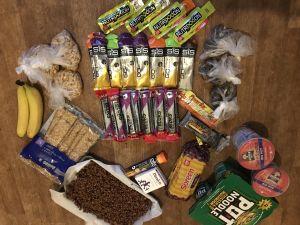
During the race I will try and eat as much natural food as possible I will supplement this with gels when I need too. My plan is to eat around 60g or carbohydrate an hour which is the equivalent to 1 banana, 1 energy gel and 2 large dates. This is a lot of food but if I eat enough I should be able to maintain my energy levels for the duration.
From experience I will crave savoury foods so hot snacks when I stop will include pot noodles, porridge pots and cheese sandwiches and maybe some ham and olives!
I will be drinking mainly water but have some Vitamin C tablets and Dirolyte as well to keep on top of my electrolyte replacement.
Every new challenge brings a new experience and opportunity to learn something about myself, my ability as a cyclist and to push my body out of its comfort zone.
See you on the other side. x

by hattenburrow | May 7, 2017 | Training
This week I started my new Training Peaks training plan. I have edited it slightly so that it fits more inline with training for 24/12 hour endurance racing.
My main training sessions are around 3 to 4 hour session where I have two or three goals for the session.
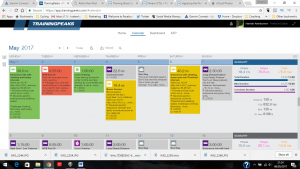
On Monday my first 3 hour session was a sub-threshold (heart rate between 139 – 147) with tempo (HR between 131 – 138) phases and hard efforts on the hills. I kept my cadence high for this session and pushed hard, harder than I needed to but I felt good and I knew that my body was capable of working a little harder so I decided to go for it! When I got home I had done 64KM in 3 hours which was an okay distance for that time. I had spent 53 mins in my sub-threshold zone and 24 mins in my tempo zone with another big block in my anaerobic capacity zone (HR between 156 – 255) I was pretty tired for the rest of the day but felt happy with my first training session on my new plan.

The rest of the week comprised of a few sessions including going back to Pilates. It was great to be back in a Pilates class and Stacey is a great teacher I left Pilates nearly as tired as I was Monday from thinking about breathing, alignment and working muscles that had been asleep for a while!
Saturday was another big endurance day this time 3 hours with the same goals sub-threshold, give it some on the hills and high cadence. I chose a new route and it turned out to be rather hilly! 1000m of climbing in fact which made for some slow cadence sections and a lot of hard efforts on the hills, these hard efforts were added to, by the fact my bike wouldn’t change down into the small ring, no amount of limit screw fettling seemed to get it changing properly so I gave up and decided I would just use it as an extra training element!
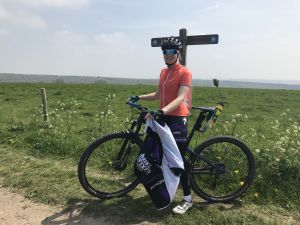
At about 2 hours 40 I was still heading North away from home and made the decision to add on another hour to my ride. It was a beautiful day and I felt strong, the only thing I was running out of was water so a quick stop at a pub to get my bottle refilled kept me on the road for an extra circuit.
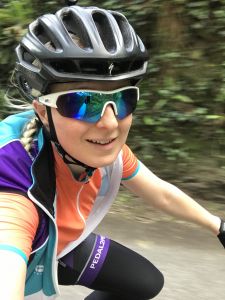
I arrived home after 4 hours covering 77.5KM with an average heart rate of 142 and a max of 181 I was really happy with my extra hour and the fact I climbed 1000m. I have only really just started training properly again since the end of February and I know from experience how quickly form drops so to pull off two good long rides in one week has left my feeling super happy.
I recommend Training Peaks to anyone looking to evaluate training it is simple to use and has some great features to help you stay on target and not over train.
Here is a brief outline on what the acronyms and numbers mean:
CTL (Chronic Training Load) is also called Fitness; it is a rolling 42-day average of your daily TSS (Training Stress Score). It indicates how much training load you are currently managing. If your Fitness(CTL) rises you are capable of handling a higher training load and therefore are more fit. If it decreases you are becoming unfit.
Watching this will indicate whether your training is working and you are improving or whether you need to put more in or have a rest day.
TSB (Training Stress Balance) is a way of measuring ‘form’ form is the magic term used for an athlete who is race ready.
Form in Training Peaks is measured by subtracting today’s Fatigue (Acute Training Load, or ATL) from today’s Fitness (Chronic Training Load, or CTL). Both Fatigue and Fitness are expressed as Training Stress Score, or TSS per day (TSS/d). Once the software has done the math, the remainder is your Form (by the way, the resulting Form value is for tomorrow—not for today.) It can be either a negative or a positive number depending on which is greater- Fitness or Fatigue. If Form is negative you are likely to be tired and probably not race ready. If Form is positive then you are probably rested and perhaps on form and ready to race.
If you would like to know more about using Training Peaks they have a brilliant blog or feel free to drop me an email.
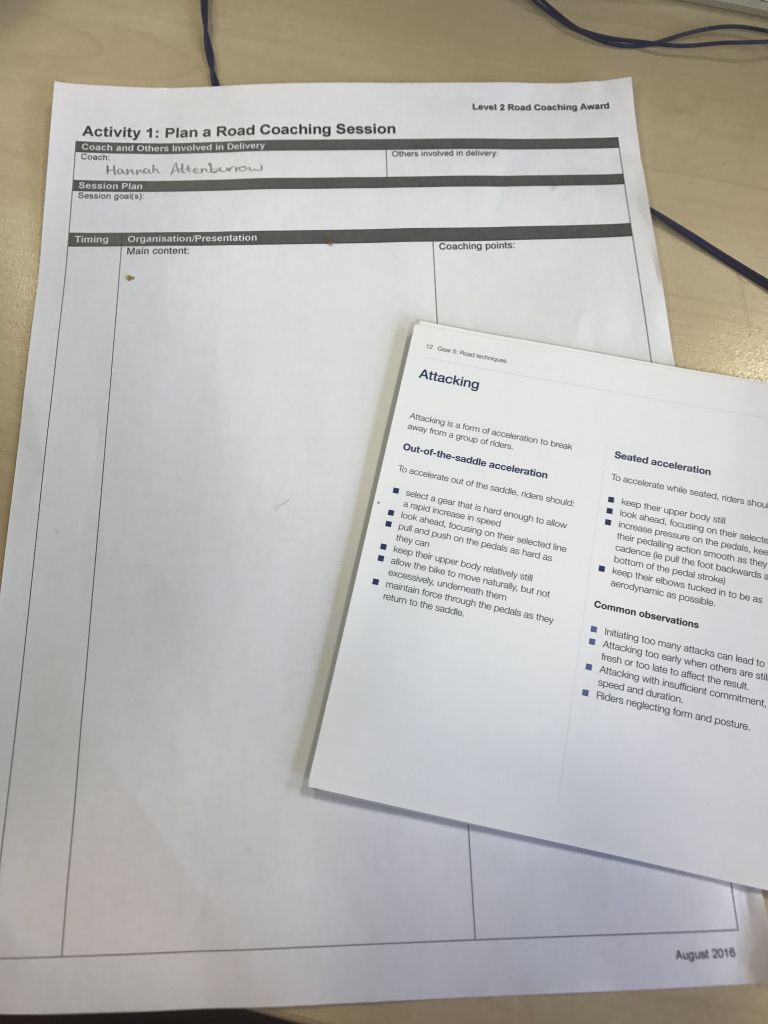
by hattenburrow | Apr 25, 2017 | Coaching, Training
Last weekend I travelled to Cyclopark in Kent to take part in my Level Two Road Cycling Course with British Cycling.
The two day course started with a development day and then assessment on the Sunday. Before the course start date we had an online learning platform where I completed a online assessment on road cycling (86% yay!) and also has to plan for a 10 minute coaching session on development day. This was also an opportunity to meet the other participants which was very helpful.
I chose countering an attack as my technique and worked on a 10 minute session which included seated and standing attacks as well as countering attacks from a bunch.
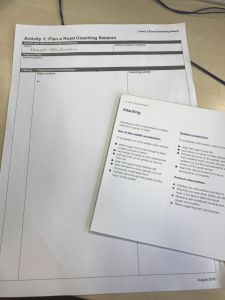
On development day we each had a chance to learn as a participant in sessions and to coach our own session. When it came to my turn I decided to leave out my first activity worried that I had packed in too much content. I started my session with an introduction which in hindsight was probably too long and then set my riders off. Sadly my session over ran as I tried to pack in far too much content. My session needed a clearer goal and refining for assessment day but I understood where I could improve it to make a more active.
The rest of the morning was spent being a participant in other people’s sessions this was really valuable as being a rider in a coaching session you can learn different ways of being coached and also look at coaching from a rider’s perspective which helps me to improve my own sessions. It was very wet and cold but the learning experience was so valuable.
In the afternoon we went through how to really drill down and create specific goals that related to types of road races and the components of fitness. This really helped me think about my own sessions and how I can create better coaching sessions with specific goals to be reached by riders by the ends of sessions.
My brain active and full of ideas I went back to my hotel Saturday ready to adapt my session plan ready for the 15 minute assessment on Sunday.
Sunday arrived and luckily the rain didn’t! My assessment went well instead of my goal being around countering an attack I looked more specifically at how riders can gain free speed. I focused on keeping my riders doing the same type of activity with subtle changes and adding in coaching points and checking for understanding as I went along.
My session went very well and I got good feedback from Richard and also lots of ideas on how I could adapt and progress my session further.
In the afternoon we did coach led racing which is different from ‘normal’ coaching sessions as you set up scenarios which could happen in a race, let it play out and then come in and discuss tactics and get feedback from the riders on what they did and how they would improve their performance. This was a really interesting way of coaching and I think with older kids and adults could work very well for coaching road and mountain bike sessions as it puts learning into practise in a more realistic setting.
I am really glad that I passed my Level two Road qualification it was a good weekend and I learnt so much and have loads of ideas for road racing sessions, now all I have to do is put some times in the diary to run some.
If you are interested in road racing coaching sessions in Hampshire and West Sussex please contact me.

by hattenburrow | Mar 10, 2017 | Coaching, Training
Should you hire a coach?
Last year I raced the Bike Trans Alp a stage race from Austria to Italy over 7 days, climbing 19,000 metres. I had never raced anything like this before. I had never ridden the distances required on multiple days let alone raced it! Climbing alpine mountains was also a new challenge, but I was excited about pushing my limits and seeing what I was capable of.
One of the key factors in getting me ‘race’ fit was hiring Mark at Velo Coaching. As a cycling coach myself I understood the basic principles of training and the sorts of sessions I should be putting together, to increase my endurance and also my ability to climb economically, however I had no real idea in how to put this together as a training plan that would allow for recovery and the adaptation in my physiology that I needed.
Mark and I worked together to look at my daily commitments like working hours, my own cycling coaching sessions and time to spend with my family. From there we plotted what type of training I could do around this and added in some important recovery time.
Having a plan made it easy for me to focus on a day at a time and not get overwhelmed with the task ahead.
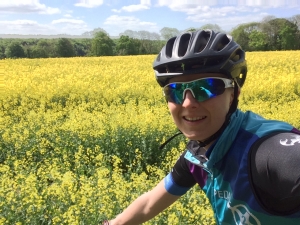
I am a self-motivated person and if I want something I am prepared to make sacrifices to make it happen, having said this, having a coach there to motivate me and analyse my progress was one of the most helpful tools. Every week Mark would look at my training and we would discuss over Training Peaks what was going well and what wasn’t. As a cycling coach myself I didn’t need hand holding through my sessions I just needed the structure to work within.
The Trans Alp bike race came round in July 2016 quicker than ever and as my Dad and I drove to Austria I felt prepared, safe in the knowledge I had put in as much training as I could manage and was as ready as I could be.

It was in the Autumn after returning from the alps I had an email from someone about coaching, they weren’t sure if they were ‘good enough’ to have a coach.
My experience is that having a coach can make a difference to the small things like, for example as I have a lot going on in my work it made the task of planning and analysing my training a weight off my mind, I new Mark was there working that out so all I had to do is put on my kit and go cycling and not put too much thought into the planning stage it was all laid out for me. I think also from a confidence point of view having a coach to say it’s okay if it doesn’t go well every race or you need to work harder on hill climbing.
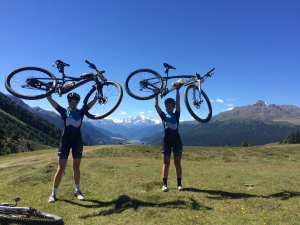
My thoughts are if you want to get better at something then it takes practise and patients. Getting expert advice whether you’re looking to just feel more confident when you’re out riding with your family or you are aiming for a challenge, anyone can grow as a rider and become better with the guidance of a good cycling coach.
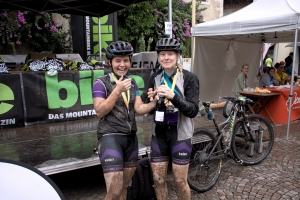
If you would be interested in me helping you, please get in touch.
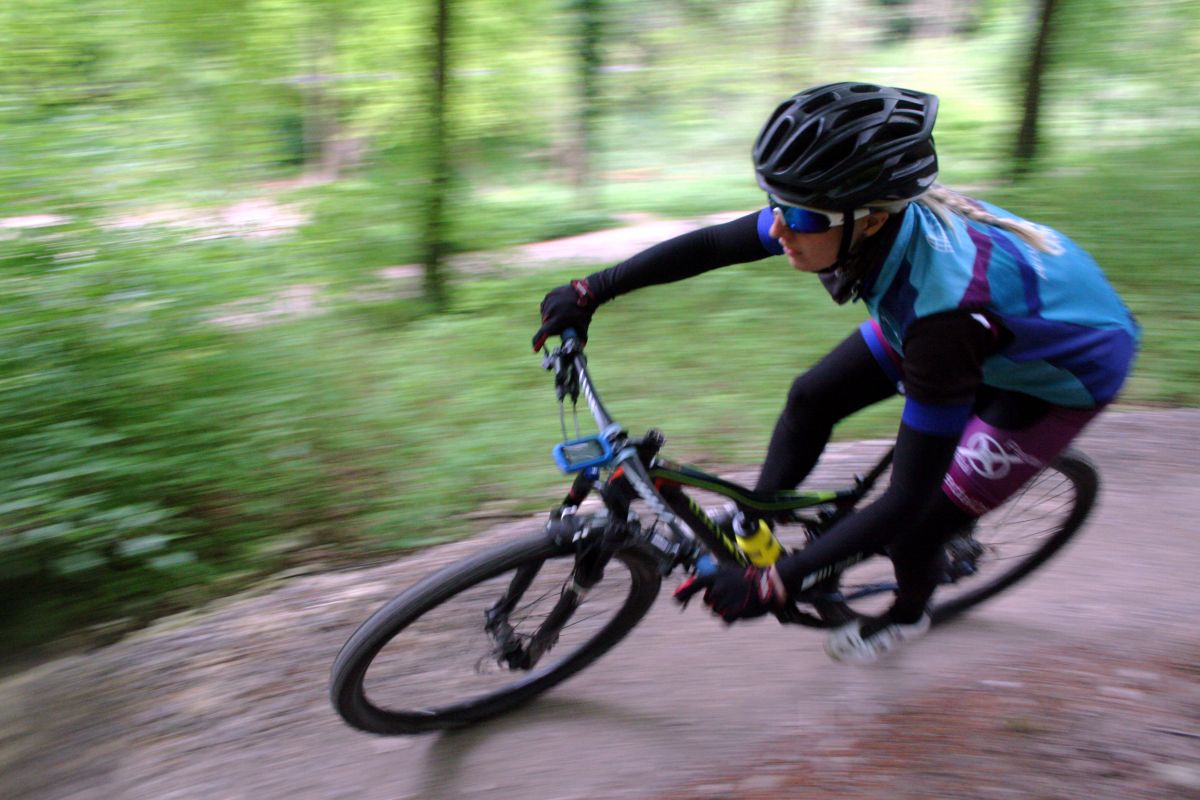
by hattenburrow | Mar 6, 2017 | Coaching, Training
I have never given / taken anything up for lent but this year my challenge is to ride to and from work at least once a week, so far so good!
For those of you who started out triumphantly giving up chocolate or bread this week and feel like 40 days is going to be a lot to bear, why not give up a cycling bad habit instead?
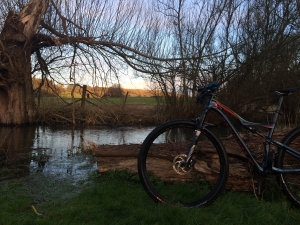
Here are my top four bad habits you could have ago at breaking.
- Not cleaning your bike after riding
Regularly cleaning and maintaining your bike reduces the impact of standard wear and tear and can lessen the chances of mechanical failures down the line. It also gives you an opportunity to check your bike over for any issues that may stop you riding next time you head to the shed.
- Going out unprepared for punctures
We’ve all been guilty of this one. About as far from home as your route allows and you suddenly feel like your dragging a dead weight, that awful feeling when you realise you have no puncture repair kit or pump… Even if your going out with friends who are usually ‘prepared’ you should be able to look after yourself. This leads nicely onto my next bad habit…
- Not knowing how to change an inner tube
I was rather shocked to find out my Mum, who is a budding road cyclist, has no idea how to change an inner tube. It is a simple skill and a vital one if you want to be independent when your cycling. I will do a video on this soon so watch this space and let me know if there are any other skills you would like to learn?
- Braking in a corner
The first rule of cornering is to scrub off all excess speed before you arrive at the corner, braking in the corner disrupts your flow and on the road can make your tyre grip less effective. My top tips to improve your technique are, scrub off all your speed before the corner, take the corner wide and head in towards the apex, when choosing your line take the straightest one possible. As you begin to exit the corner, keep looking ahead up the road to ensure you spot and anticipate any obstacles or hazards.
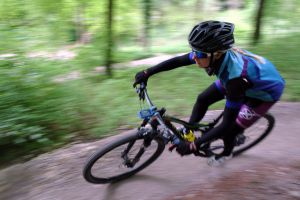
Thanks for reading, I hope you have enjoyed my blog post.




